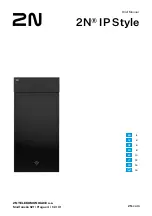
CAN-8x23 user’s manual (Revision 3.20, Ma r/08/2012) ------
26
Object Dictionary
The object dictionary collects a lot of important information which can
affect
device’s reaction, such as the data accessing through I/O channels, the
communication values and the network states. Essentially, the object
dictionary consists of a group of entry objects, and these entries can be
accessed via the node network in a pre-defined method. Each object entry
within the object dictionary has its own function, for example communication
parameters, device profile, data type (ex. 8 -bit Integer, 8-
bit unsigned…), and
access type (read only, write only …). All of them are addressed in a 16-bit
index and an 8-bit sub-index. The overall profile of the standard object
dictionary is shown below.
Index
Object
0x0000
Reserved
0x0001 - 0x001F
Static Data Types
0x0020 - 0x003F
Complex Data Types
0x0040 - 0x005F
Manufacturer Specific Complex Data Types
0x0060 - 0x007F
Device Profile Specific Static Data Types
0x0080 - 0x009F
Device Profile Specific Complex Data Types
0x00A0 - 0x0FFF
Reserved for further use
0x1000 - 0x1FFF
Communication Profile A rea
0x2000 - 0x5FFF
Manufacturer Specific Profile Area
0x6000 - 0x9FFF
Standardized Device Profile Area
0xA000 - 0xBFFF
Standardized Interface Profile Area
0xC000 - 0xFFFF
Reserved for further use
Take the standardized device profile area as an example. Assume that a
CANopen device has 16 DI, 8 DO, 2 AI and 1 AO channels. The values of
these channels will be stored in the Standardized Device Profile Area,
especially the entries with indexes 0x6000, 0x6200, 0x6401, and 0x6411.
When the CANopen device obtains the input value, these values will be stored
in the 0x6000 and 0x6401 indexes. Furthermore, the values stored in the
0x6200 and 0x6411 indexes will also output to the DO and AO channels. The
basic concept is presented as follows.
















































